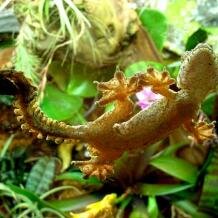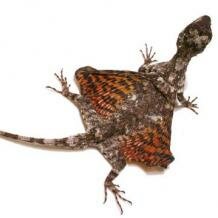Topic: Gliding in Draco lizards and tree snakes
“The agamid lizard genus Draco (consisting of the so-called ‘flying dragons’) exhibits an array of morphological traits associated with gliding.” – A.P. Russell & L.D. Dijkstra (2001) Journal of the Zoological Society of London, vol. 253, page 457
 The ability to glide has evolved independently in a surprising diversity of animals, including reptiles, mammals, frogs, ants, fish and even in some species of squid. Gliding is defined as descent through the air at an angle of less than 45° to the horizontal, and this mode of locomotion has been achieved through a range of impressive morphological and behavioural adaptations that generate the required aerodynamic forces (upward ‘lift’ exceeding air resistance, or ‘drag’).
The ability to glide has evolved independently in a surprising diversity of animals, including reptiles, mammals, frogs, ants, fish and even in some species of squid. Gliding is defined as descent through the air at an angle of less than 45° to the horizontal, and this mode of locomotion has been achieved through a range of impressive morphological and behavioural adaptations that generate the required aerodynamic forces (upward ‘lift’ exceeding air resistance, or ‘drag’).
Among the distinct mechanisms of gliding that are known, several provide excellent case studies in convergent evolution, as they have evolved repeatedly in unrelated groups. Our current example deals with a number of distantly related reptile species in which we find lateral wing-like membranes (technically termed ‘patagia’) that are supported by musculo-skeletal adaptations that result in excellent gliding performance: One agamid lizard (Draco, the ‘flying dragon’) and four lineages of extinct reptiles have independently evolved a pair of gliding membranes that expand laterally from the dorsal trunk region, supported by rod-like structures made of modified, elongated ribs or dermal bone deposits within the skin. The lateral patagia are unfolded through the action of specialised muscles and ligaments, permitting control of direction and velocity in the air.
Gliding membranes
 In the agamid genus Draco, elongated dorsal thoracic ribs support a broad patagium that flares outwards between the fore- and hind-limbs; membrane extension and movement during flight is under voluntary control, dependent on rib-associated muscles and ligaments. Draco glides from tree to tree in search of food, mates, to chase territorial males, and to avoid predators; smaller species (e.g. D.melanopogon and D. quinquefasciatus of Borneo) tend to occupy lower levels of the trees, as their large wing surface area : body mass ratio requires a shorter initial ‘ballistic dive’ before achieving enough lift for a level glide, whereas larger species (e.g. D. fimbriatus) are high canopy specialists, requiring an initial launch from higher up to generate enough lift to carry their greater body mass.
In the agamid genus Draco, elongated dorsal thoracic ribs support a broad patagium that flares outwards between the fore- and hind-limbs; membrane extension and movement during flight is under voluntary control, dependent on rib-associated muscles and ligaments. Draco glides from tree to tree in search of food, mates, to chase territorial males, and to avoid predators; smaller species (e.g. D.melanopogon and D. quinquefasciatus of Borneo) tend to occupy lower levels of the trees, as their large wing surface area : body mass ratio requires a shorter initial ‘ballistic dive’ before achieving enough lift for a level glide, whereas larger species (e.g. D. fimbriatus) are high canopy specialists, requiring an initial launch from higher up to generate enough lift to carry their greater body mass.  Dorsal ribs have been found to support gliding membranes in several extinct reptiles, including the basal squamate Xianglong zhaoi (Early Cretaceous), Late Triassic lepidosaurs Kuehneosaurus and Icarosaurus siefkeri, and the very distantly related mid-Triassic (220 Ma) archosaur Mecistotrachelos apeoros.
Dorsal ribs have been found to support gliding membranes in several extinct reptiles, including the basal squamate Xianglong zhaoi (Early Cretaceous), Late Triassic lepidosaurs Kuehneosaurus and Icarosaurus siefkeri, and the very distantly related mid-Triassic (220 Ma) archosaur Mecistotrachelos apeoros.
A late Permian lepidosaur has been identified as gliding on a rod-supported patagium, but in this species – Coelurosauravus jaekeli – the support structure is not rib derived, but made of bony material deposited within the skin.  Our understanding of reptile relationships reveals that these reptiles all evolved rod-supported patagia independently, a conclusion supported by observed variation in patagium outline, aerodynamic properties and precise musculo-skeletal arrangements between species. Indeed, the extinct Xianglong exhibits possibly the most aerodynamic and maneuverable rib-supported patagium, with a typical aerofoil cross section (thickened at the leading edge, tapered to the trailing edge) and wings that were much longer laterally than antero-posteriorly (in contrast to Draco, for example, whose ‘wing’ patagium is longer in the anterior-posterior dimension than transversely).
Our understanding of reptile relationships reveals that these reptiles all evolved rod-supported patagia independently, a conclusion supported by observed variation in patagium outline, aerodynamic properties and precise musculo-skeletal arrangements between species. Indeed, the extinct Xianglong exhibits possibly the most aerodynamic and maneuverable rib-supported patagium, with a typical aerofoil cross section (thickened at the leading edge, tapered to the trailing edge) and wings that were much longer laterally than antero-posteriorly (in contrast to Draco, for example, whose ‘wing’ patagium is longer in the anterior-posterior dimension than transversely).
Furthermore, Mecistotrachelos was probably more maneuverable than Draco, owing to thickened elongated ribs near the base of its unusually long neck, suggestive of strong muscle attachment for excellent control over its membranous ‘wings’. Beyond general comparisons of gliding patagia, the Cretaceous lizard Xianglong points to a more subtle instance of convergent evolution, as it strengthens its patagium with parallel collagen fibres in a manner only seen elsewhere in very distantly related taxa, namely the pterosaurs (capable of true flight) and the Triassic delta-wing glider Sharovipteryx, indicating that these three reptile groups independently converged on the use of collagen fibres to critically reinforce flight membranes.
Gliding tree snakes
 In discussing reptiles with rib-supported patagia, it would be impossible to avoid a most fascinating group of gliders, namely the gliding tree snakes. Two species of tree snake from the forests of S.E. Asia have been well studied; they are the paradise tree snake Chrysopelea paradisi, and the golden tree snake C. ornata of the snake family Colubridae. These snakes use a uniquely specialised body shape and aerial behaviour to produce controlled glides that equal the performance of the gliding agamid Draco melanopogon. The research of J. J. Socha has shown that Chrysopelea paradisi achieves lift, after jumping into a dive from a perch in the trees, by passing “lateral travelling waves posteriorly along a long dorsoventrally flattened body”.
In discussing reptiles with rib-supported patagia, it would be impossible to avoid a most fascinating group of gliders, namely the gliding tree snakes. Two species of tree snake from the forests of S.E. Asia have been well studied; they are the paradise tree snake Chrysopelea paradisi, and the golden tree snake C. ornata of the snake family Colubridae. These snakes use a uniquely specialised body shape and aerial behaviour to produce controlled glides that equal the performance of the gliding agamid Draco melanopogon. The research of J. J. Socha has shown that Chrysopelea paradisi achieves lift, after jumping into a dive from a perch in the trees, by passing “lateral travelling waves posteriorly along a long dorsoventrally flattened body”.
During descent the ribs are splayed outwards so that the ventral (lower) surface is concave, and in combination with stereotypic lateral undulations, the whole body effectively functions as a single, aerodynamic wing. C. paradisi has more concave ventral surface than C. ornata, and it also has lower body mass for its length, making it a better glider than C. ornata, capable of gliding more than twice as far between the trees, chasing prey or avoiding predation. Although not structurally identical to Draco-type gliding lizards, the principle of using expanded ribs is the same, representing a convergent adaptation for generating lift.
Cite this web page
Map of Life - "Gliding in Draco lizards and tree snakes"
https://mapoflife.org/topics/topic_344_gliding-in-draco-lizards-and-tree-snakes/
November 29, 2020

